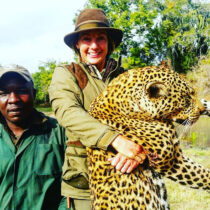
If you hunt lion with your heart then you hunt leopard with your brain! Leopards are one of the most difficult animals to successfully hunt. It takes planning and the right technique to fool this illusive animal. When hunting Leopard I run multiple baits for different male cats. The territory of a mature Tom is large and constantly under his patrol. Females and food can slow him down and throw off his schedule. Typically, a leopard will cover his territory every 7 – 14 days depending on distractions and the size of his territory. In game rich environments, leopards tend to travel less due to smaller territories. In other places, I have noticed big males crossing the same locations only once every three weeks. They operate mainly at night. Catching a glimpse of a leopard in the daylight is a rare sight in Africa. They frequent easy travel corridors, such as riverbeds and hunting roads. Thick cover or rocky outcroppings provide them with secure daytime hangouts and good ambushing points for hunting leopard.
Due to the animals reclusive nature successful leopard hunters will book a minimum of 14 days on the ground in the hunting area. Available meat is strategically secured to a climbable tree in an area the leopard frequents. The scent of guts and stomach contents, along with blood and decaying flesh attract the cat to the bait. The bait is typically in the dense area or thicket, close to his favorite travel routes. The dense bush helps the cat to feel secure and encourages him to feed in daylight hours. A blind is built on active bait and the wait in on! Blind location is dictated by terrain and wild direction. The approach to the blind is also very important. We take great care to look after all these important details. Shots are typically 50-70 yards and are from a set position. Accuracy is very important for leopard hunting. You will have one shot. More often than not, a wounded leopard will charge. They are very fast and can cause a hunter a lot of stitches in a very short amount of time. Trophy size is dictated by skull size. Weights of the cats fluctuate greatly and are often exaggerated by hunters.
Overall length of a cat is often discussed by hunters and is not usually reliable information. Leopard are CITIES I animals and are allowed to be imported to the United States. Hunting quotas are strictly issued and a limited number of tags are available for leopard hunting.
General Leopard Information
- Size: Shoulder height 30 inches, male weight around 150 lbs. Size can vary depending on the area. Females are typically 20% -40% smaller than males. Many hunters and ph’s over estimate the weight of leopard or their scale has not been calibrated correctly. Any cat weighing over 150 pounds is huge.
- Color: Ground color is off-white to golden, with black spots on the legs, shoulders, head and hindquarters, and irregular, light-centered ‘rosettes’ scattered profusely over the back and sides.
- Potential Longevity: 20 years (5- 10 years shorter in the wild)
- Most Like: Leopards are most like the Cheetah, but the leopard is heavily built and has no tear marks from corner of eye to corner of mouth. The leopard’s main body markings are rosettes and not solid spots like those of the cheetah.
- Habitat: Leopards have a very wide range of habitat tolerance, from rainforest to semi-desert, including savanna, mountainous areas and rocky hills. Leopards naturally occur in most parts of the African subcontinent and many parts of Asia.
- Habits: Leopards lead a solitary lifestyle. Males inhabit territories of 5 to 40 square km, which may overlap with the territories of several females. They are very defensive of their territory and urinate around the boundaries of their territories to warn off intruders. They are most active between sunset and sunrise. Leopards often take their kills up into the safety of tree branches, to avoid the attention of hyenas and lions. They are incredibly strong and are capable of lifting carcasses three times their own body weight, placing them on branches over 6m high. There have been several reports of leopards hauling young giraffes into trees.
- Diet: They have a number of prey items, including gazelles, antelopes, monkeys, jackals, duiker, eland, impala, insects, wildebeest, rodents, hyraxes, hares, peacocks, snakes, sheep and goats. Leopards can live independently of water for long periods of time, obtaining liquid from their prey.
- Reproduction and Gestation Period: The Leopards gestation period is between 90 – 100 days (3 months).

















































